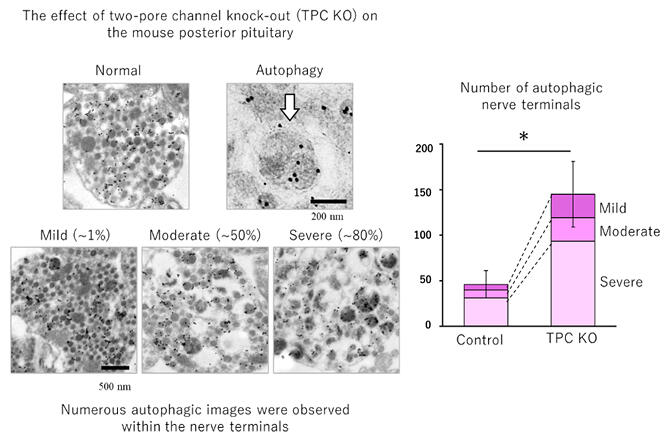An international research group led by graduate student Natsuko Kawakami and Professor Hirotaka Sakamoto of the Graduate School of Environment, Life, Natural Science and Technology at Okayama University, as well as the University of Oxford (UK) and the Université Paris‐Saclay (France), has revealed that two‐pore channels, a type of ion channel, regulate social behavior in mice by promoting the release of oxytocin.

Provided by Okayama University
Two‐pore channels are widely expressed in the membrane systems of animal and plant intracellular organelles and are known as an evolutionarily important membrane protein of the voltage‐gated ion channel superfamily. A marked reduction in oxytocin‐releasing activity and reduced maternal behavior had been observed in mice lacking the two‐pore channel gene (KO), but the cause has remained a mystery.
In their study, the researchers revealed that two‐pore channels induce oxytocin exocytosis, in particular priming (fusion of the granule vesicle membrane with the plasma membrane), by increasing the local intracellular concentration of Ca2+. Furthermore, oxytocin concentration in blood was markedly reduced and the release of oxytocin within the hypothalamus was also inhibited in two‐pore channel KO mice, indicating that priming of granule vesicles, which triggers the action of the two‐pore channel, is important for the neural activity‐dependent release.
Conversely, in the posterior pituitary, which is normally the site of oxytocin release, excess granule vesicles containing oxytocin that were not released were found to undergo autophagy (self‐eating) by lysosomes. Immunoelectron microscopy analysis revealed significantly more autophagy‐like images in oxytocin neurons in the posterior pituitary of two‐pore channel KO mice than in the control group.
This suggests that the suppression of oxytocin release in two‐pore channel KO mice promotes granule vesicle autophagy in the posterior pituitary.
"We have shown that two‐pore channels regulate social behavior by stimulating the release of oxytocin, known as the love hormone," explained Sakamoto. "Dysfunctional two‐pore channels may be responsible for social disorders such as autism spectrum disorder, and we expect novel therapies to be developed."
■ Oxytocin: A neuropeptide hormone released into blood from posterior pituitary gland and closely related to motherhood, including myometrial contractions during parturition and milk ejection. In recent years, it has also attracted attention for its deep involvement in social behavior as a love and bonding hormone.
This article has been translated by JST with permission from The Science News Ltd. (https://sci-news.co.jp/). Unauthorized reproduction of the article and photographs is prohibited.




